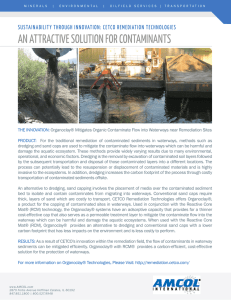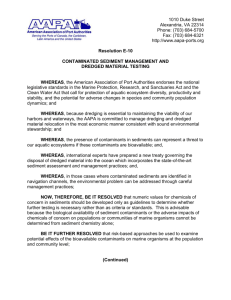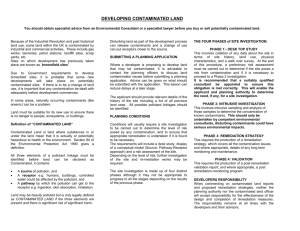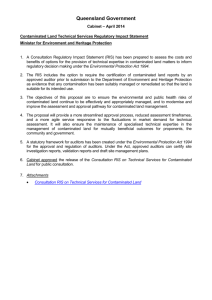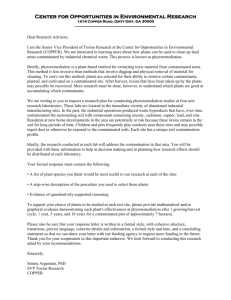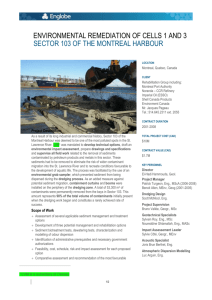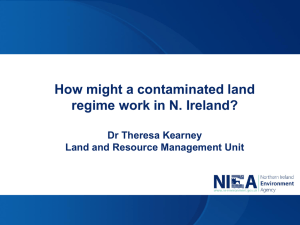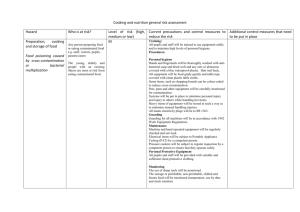INNOVATION TO MARKET TWO- PAGE SUMMARY EXAMPLE
advertisement
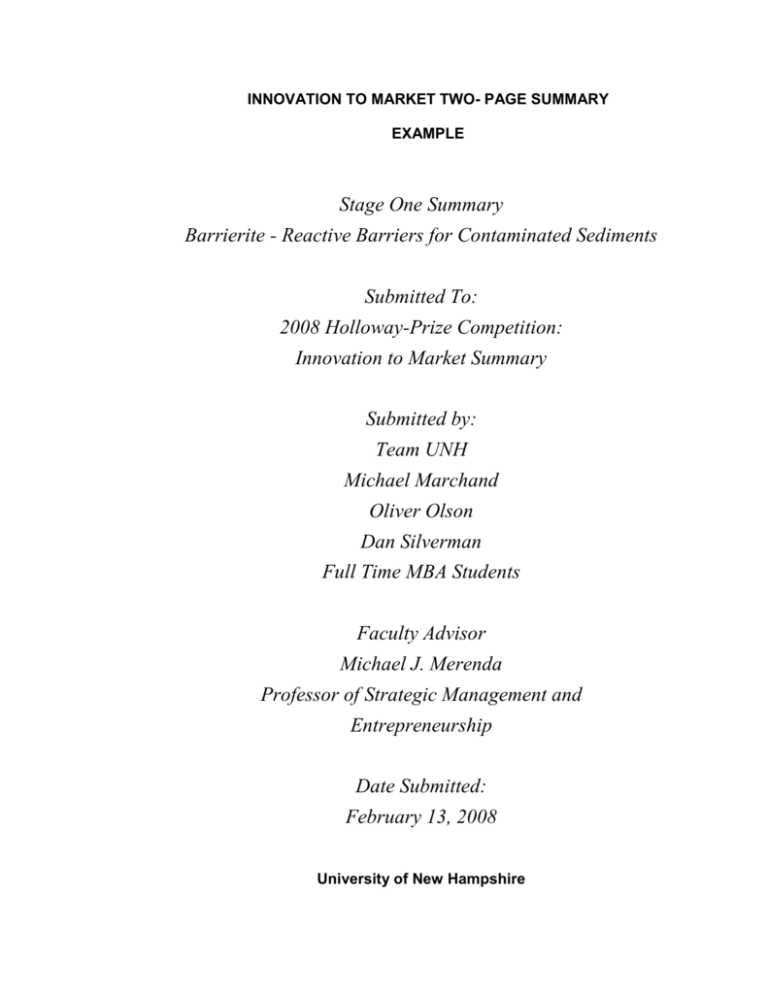
INNOVATION TO MARKET TWO- PAGE SUMMARY EXAMPLE Stage One Summary Barrierite - Reactive Barriers for Contaminated Sediments Submitted To: 2008 Holloway-Prize Competition: Innovation to Market Summary Submitted by: Team UNH Michael Marchand Oliver Olson Dan Silverman Full Time MBA Students Faculty Advisor Michael J. Merenda Professor of Strategic Management and Entrepreneurship Date Submitted: February 13, 2008 University of New Hampshire INNOVATION TO MARKET 2 TWO PAGE SUMMARY EXAMPLE Barrierite - Reactive Barriers for Contaminated Sediments 1. What is the actual product or service? Barrierite™ is a permeable reactive barrier technology that employs phosphate-based minerals in engineered structures for the remediation of contaminated sediment in waterways. It is specifically targeted to immobilize inorganic pollutants including lead, copper, arsenic, and uranium. 2. What is the innovation that underlies your product or service? Heavy metals accumulate in waterway sediments by deposits from industrial activity. These pollutants can then diffuse back into the water and become particularly hazardous to organisms at the base of the food chain. Barrierite utilizes phosphate-based minerals that bind the metals in a specifically engineered application. It may be implemented within a geotextile mat or placed in loose granular form 3. What makes the innovation unique? The Barrierite technology uses phosphate minerals, typically naturally occurring apatites, to facilitate the immobilization of inorganic pollutants. The alternative methods fall short because they fail to stabilize the harmful pollutants. For example, Barrierite is 1000 times more effective at immobilizing lead than a traditional sand cap. In addition, the Barrierite technology does not require any special equipment for deployment compared to the alternative technologies. 4. What is innovative, if anything, about your business model? How do you expect to make money from your product or service if existing competition offers same or similar products or services? The phosphate-based solution employed by Barrierite is the only remedy that chemically binds and neutralizes the array of metallic pollutants commonly found in polluted waterways. Existing alternatives include sand capping and environmental dredging. Sand capping only creates a physical barrier between the water and pollutants by placing several feet of sand over the contaminated sediment. This serves only as a temporary barrier as the metals eventually diffuse back into the water column. Environmental dredging is a costly and timeconsuming procedure that physically removes the contaminated sediment from the waterway. However, the dredged material is still hazardous; it must be relocated and treated. Additionally, some residual contaminants remain in the waterway after the dredging process. There are three sources revenue from Barrierite™: (1) U.S. Army Corps of Engineers, EPA contracts; (2) Consulting Services to Environmental Engineering Firms; (3) On-site management and afterinstallation monitoring of contained, designated environmental sites. Secondary revenue sources target longer term are contracts and consulting services to the mining industry (contaminated waste products) and the military applications (munitions test sites). 5. Who are your top competitors? What threats do they pose? There are currently 2808 firms which are classified under NAICS code 562910, remediation services with total sales exceeding 7.8 billion dollars. While Barrierite™ will be marketed as a process to assist clients in obtaining the phosphate material, and to provide technical expertise in an efficient and cost-effective application of the material, many of these firms, especially the larger firms offer existing competitive products. The biggest threat posed is the legacy affects of existing industry standards. 6. Who are your first customers? Why will they buy your product or service? The initial customer group consists of (i) large environmental technology application firms that provide services for United States government agencies or large industries, (ii) port and harbor authorities, and (iii) the U.S. Army Corps of Engineers. The technology is an improvement on traditional capping and can be used as a substitute or to complement dredging. Barrierite application requires less dredging therefore mitigating the high costs of transporting and storing the contaminants because it can contain the pollutants at its location. Barrierite is also more permanent than the sand capping method because it chemically stabilizes the contaminants. In addition, Barrierite can also be used under piers and along seawalls where environmental dredging is not an alternative. 7. What is the general size of your primary market? According to the U.S. EPA, 20% of all U.S. waterways are contaminated. The EPA estimates that in the U.S., mining waste alone has contaminated 12,000 miles of streams and rivers and 180,000 acres of lakes. The U.S. Navy estimates 1.2 billion cubic yards of harbor sediments have been contaminated by its activities and the cost of remediation is expected to exceed one billion dollars just for these facilities. The Barrierite technology promises to be an effective tool in pollution remediation at many of these sites. 8. How do you anticipate developing intellectual property (IP) protection for your product, service innovation or business model? The application of this technology is protected under the United States patent 6,209,637. This patent provides for the use of phosphate-based minerals as an underwater pollution remediation method in (i) slurry form, (ii) blended matrix form with other inorganic agents, or (iii) composite form with a geotextile or geofabric. 9. What quality of life "pain or problem" does your product, service or business model address? Many coastal regions in the United States have high heavy metal contaminant levels in their sediments. Heavy metals are some of the most prevalent contaminants in underwater sediment and are problematic with respect to dredge material management. Heavy metal contamination may damage marine organisms and affect the ecosystem. Fish acquire heavy metal accumulation in their bodies from living in contaminated water, residing in contaminated sediment, or eating contaminated food. A continued cycle of pollution could result in long-term exposure to these metals through human consumption of contaminated fish. Consequently, it may lead to adverse health effects in human beings. Lead and mercury are particularly hazardous to human conditions and pose the most widespread health risks. As the public outcry for cleaner rivers increases, the Environmental Protection Agency will be pressured to employ stricter legislation on the prevention and remediation of heavy metal contamination in the sediments of US waterways. Because Barrierite™ is specifically engineered to target inorganic pollutants in contaminated sediment, it provides a remediation technique that can effectively neutralize the negative effects of contamination and help to quickly restore the habitat.
